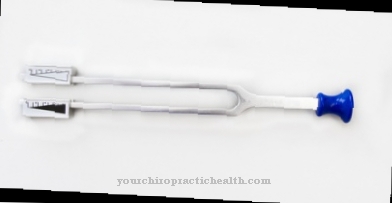The Suction cup is an obstetrical instrument. It is only used in the event of complications during delivery.
What is a suction cup?

A suction cup is a medical instrument used to bring an infant into the world. This process is also known as suction bell birth or vacuum extraction.
The use of a suction cup is only considered, however, if unforeseen complications occur during the birth process that can have life-threatening consequences for either the child or the mother. This includes, for example, a lack of oxygen in babies.
How deep the baby is in the birth canal also plays an important role. It is important to carefully weigh up between a suction cup delivery, a forceps delivery or a surgical caesarean section.
In Germany, almost 5 percent of all children are born using a suction cup each year.
Shapes, types & types
There are two different types of suction cups. These are the conventional suction cup and the so-called kiwi suction cup. The kiwi suction bell is a disposable bell. While the conventional bell is operated by an electric motor, the Kiwi version only has a handle with which the doctor manually generates negative pressure. Since the pressure build-up with the kiwi suction cup is slower, this process is considered gentler on the child. This version is also easy to use. Basically, giving birth with a suction cup is seen as gentler than giving birth with forceps.
The size of a suction cup (also called a Vacuum extractor labeled) is 40, 50 or 60 millimeters. While the material of the bell was mostly made of metal in earlier years, nowadays mainly silicone is used. Other possible materials are rubber and plastic.
Structure & functionality
The suction bell is a round bowl. The instrument has a hose on its outer side that connects the bell with a vacuum pump. There is also a pull chain on the bell.
To bring the baby into the world, the obstetrician places the bowl on the child's skull. The hose then sucks air out of the shell, creating a vacuum in it. The inside of the suction cup is pressed strongly against the child's skull. Once the shell has been sucked tight, the doctor pulls on the pull chain that sits on its curve.
This happens during the labor of the mother, who presses along with this process. In this way the birth process is accelerated. When the baby's little head comes out, the direct vacuum suction ends. The rest of the baby's body is then born.
Before the suction cup is inserted, the mother's bladder usually has to be emptied, which takes place via a catheter. In addition, the gynecologist carries out an internal examination. It is used to determine the position of the baby's head. The extent of the lowering is also determined. This examination is extremely important for the correct adjustment of the suction cup on the child's skull.
Once the doctor has finished the examinations to the satisfaction, he attaches the suction cup to the baby's head. After just a few minutes, the instrument attaches itself to the baby's skull. The tensile strength of the bell is usually reached when the negative pressure is 0.8 kg / cm². Before starting the procedure, the doctor carries out a test pull on the chain.
In order for a suction bell to be used, certain conditions must exist. This includes the opening or cracking of the amniotic sac, the complete opening of the cervix, the correct application of the suction cup, and the implementation of a perineal incision. In addition, the baby's head must be within the small pelvis.
Medical benefit
The use of a suction cup can be critical to the health of both mother and child. The final phase of childbirth is extremely stressful for both mother and baby. For example, there is poor blood flow to the placenta, as well as strong pressure on the baby's head. This creates the risk of insufficient blood flow to the brain. Sometimes the child's heart rate slows down. The birth process can then be accelerated with the help of a suction cup. However, severe exhaustion of the mother can also make the use of a suction cup necessary.
Although the suction cup birth is considered relatively safe, complications and side effects are still possible. This includes u. a. the head lump. This is the swelling of the subcutaneous tissue, which is caused by the bell. However, the swelling is not unusual and is considered normal. As a rule, the tumor regresses quickly.
However, if the pressure changes too quickly when the suction cup is attached or removed, injuries to the scalp are possible. Even dangerous cerebral hemorrhages can occur. The use of a suction cup also carries certain risks for the mother. These include increased tearing of the perineal incision or cracks in the cervix.
A suction cup may not be used in the case of a premature birth. Since there is an increased risk of cerebral hemorrhage here.
The suction cup delivery basically has the advantage that, compared to the forceps delivery, injuries to the mother occur less often. Furthermore, it is easier to compensate for missing adaptations of the child's head to the mother's small pelvis.






.jpg)




















